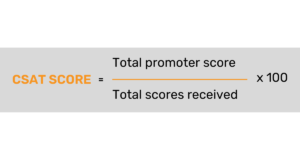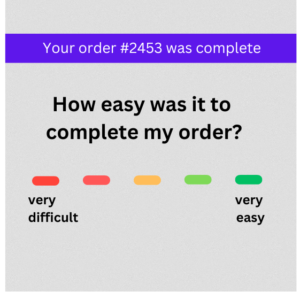In the current retail industry, it is not enough to simply sell products. The success of a business depends on how well it can meet the needs and expectations of its customers. This is where customer feedback comes into play. Collecting feedback from customers at every touchpoint can provide valuable insights that help businesses improve their products and services, enhance customer experiences, and ultimately boost sales. In this blog post, we will discuss the importance of customer feedback in the retail industry and how to capture it effectively using various methods. We will also cover measuring customer satisfaction with CSAT scores, analyzing feedback data with tools, creating meaningful surveys, implementing a customer feedback roadmap and taking actions via processes.
Capturing Customer Feedback for Retail Industry
Collecting customer feedback is vital for any retail business as it helps in making data-driven decisions and improving overall customer satisfaction. Identifying key touchpoints like email, social media platforms and using different forms of surveys or reviews are some of the best ways to gather qualitative feedback from customers. Keeping the process simple increases response rates and improves the product roadmap. Responding promptly to customers’ pain points builds trust with loyal customers and helps retain new customers.
Messenger based surveys
Using Whatsapp surveys and Facebook messenger surveys , the customer support team can capture instant feedback especially when a post purchase survey is concerned. This will help them keep the transaction in context in nature, such that the buyers do not forget the experience the minute they leave the store. Instant feedback will bring a high response rate and the results will stay authentic.
Dynamic email surveys
AMP facility as provided by Google is a boon. This allows marketers to create dynamic email responses where users need not go to an external browser via their email address. The respondents can reply to the feedback right in the mailer. All responses get recorded in the dashboard. This facility will also bring a high response rate since users can directly reply within the email body itself. It keeps the experience interactive.

In-app survey and web based chat bots
In-app surveys are very useful after a buyer clears a transaction or a purchase within the application. The in-app surveys can be in the form of an NPS score or a 5 star rating system. It can also seek an open-ended response for a more nuanced feedback.
The web based chatbots are very useful when people are browsing websites or they are present on social media sites. A web based chatbot survey can be deployed in any medium- Twitter direct messages, on Instagram DM or on Whatsapp messenger. It can capture superfast responses and segregate data on the dashboard.
Measuring Customer Satisfaction at Touchpoints
By using metrics like Net Promoter Score (NPS), Customer Satisfaction Score (CSAT), and Customer Effort Score (CES), retailers can engage with unhappy customers quickly. Having a robust feedback loop by implementing a chat or phone call support team can help solve issues faster while retaining potential customers.

The CSAT feedback template
CSAT means customer satisfaction score. It seeks responses based on the level of satisfaction a consumer might have gone through, in a touchpoint or with an experience. It can be rated between “highly satisfied to highly unsatisfied”. One can make it visually appealing with colours and visual emojis.
The NPS feedback template
NPS is a net promoter score which is a gold standard of understanding if a consumer will recommend a service or a product. The scale will denote promoters, detractors or passive respondents. Marketers can gauge promoters from detractors and use this data to customize their communication with either happy or unhappy customers.

The CES feedback template
CES means customer effort score and it was formulated by Gartner. This denotes the level of effort a consumer has to go through in a touchpoint. It can be for seeking information, conversation with service executives for product assistance or addressing complaints. Effort is now an important metric to understand the level of pain or friction a user has to face in the business ecosystem.
Analytics for Customer Feedback Data
Marketers can opt for two kinds of feedback- qualitative and quantitative. Closed-ended feedback and open ended feedback are to be analyzed differently. For closed ended satisfaction metrics, the data is mapped into bar graphs, charts and mapped on real time trends and analysis. Open ended feedback involves the use of multimedia insights.
Open-ended responses
Open-ended responses include asking for detailed responses in a survey. This also includes seeking feedback via multimedia formats- audio, video or photos. This makes the data collection , media rich. Qualitative feedback adds more depth to the surveys. To individually assess and read responses, marketers would require patience to understand the emotional context of each individual reply. These replies can also be mapped on a word cloud which will segregate positive and negative words for a better understanding.
Closed-ended responses
This customer satisfaction metric involves in-app surveys, rating scales, NPS survey, ranking scale and CSAT scores to name a few. This metric collects clear, concise and precise data that can be mapped. This also helps organisations close feedback loops when any negative feedback comes into the picture. One can understand unhappy customers, assist detractors and opt for cross selling and promoting more products among happy customers. This brings a clear demarcation between happy users and unhappy consumers. It is important to attend to every type of feedback- be it a thank-you note, customer loyalty points or a survey incentive.
It is recommended that marketers can also use survey templates to curate questionnaires since a lot of them are predesigned and pre tested to avoid errors and remove biases. Merren also provides plenty of survey templates for feedback surveys.
Implementing a customer feedback roadmap
Implementing a customer feedback roadmap allows businesses to gather valuable insights from customer interactions. This empowers them to make informed decisions about product development and refine their offerings. A successful feedback roadmap takes into account both customer experience and user experience, recognizing that they go hand in hand. It’s important to remember that implementing a customer feedback roadmap is not a quick fix, but rather a journey towards building a stronger relationship with customers and creating products that truly meet their needs. By actively listening to customer feedback, analyzing it, and incorporating it into the development process, businesses can ensure that their products and services are aligned with customer expectations and continuously evolving to meet changing demands.
Taking action on customer feedback
Taking action on customer feedback is crucial for businesses seeking to improve their products and services. By actively monitoring online reviews and conducting market research, companies can gain valuable insights into customer preferences and pain points. Additionally, engaging customers through surveys allows for direct feedback and fosters a sense of loyalty. Armed with this information, businesses can implement a customer feedback strategy that aligns with their goals, such as enhancing customer retention and driving growth. Involving marketing team members and collaborating with customer success teams ensures a comprehensive approach to address feedback promptly and effectively, leading to better customer satisfaction and long-term success.
Conclusion
The right way to go about understanding a touchpoint is to map out the points of contact that your consumer base might use frequently. It can be via social media websites, chat bots inside the websites, call number for customer’s needs or via email support. The retail industry- especially virtual ecommerce stores have different touch points since the consumers are mostly on their cellular devices or desktops. Focus on primary points of contact and collect customer feedback via customer surveys. Merren provides different methods to gather customer feedback. To know how these new features can supercharge the feedback process, sign up for a 14 day free trial today.





